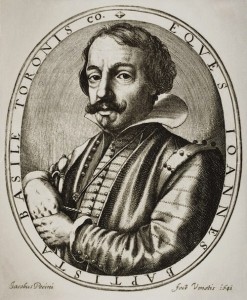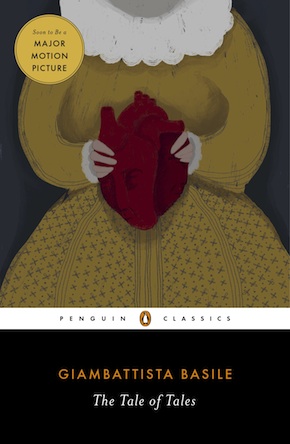An assignation
by Giambattista BasileThe Tale of Tales by Giambattista Basile is the first authored collection of literary fairy tales in the Western European canon, predating the work of Charles Perrault, the Brothers Grimm and Hans Christian Andersen.
An inspiration for storytellers from Shakespeare to Calvino, the long-overlooked 17th-century collection includes the oldest known written versions of some of our best loved fairy tales – from ‘Cinderella’ and ‘Sleeping Beauty’ to Rapunzel’ and ‘Hansel and Gretel’. Made up of forty-nine tales within a fiftieth frame story, and told over five days, the book is inhabited by a magical world of dragons, ogres, kings and queens, evoked in lively prose with surprisingly modern psychological depth.
As Matteo Garrone’s stunning English-language film based on some of the tales is about launch in the UK, Penguin Classics has issued a new edition in which Nancy Canepa delivers the first full, annotated English translation of the original Neapolitan text, and reveals the rich history and wit behind Basile’s words to English readers for the first time. If you’re unfamiliar with the stories, it’s an essential read ahead of the film’s release.
Using a style that blends eroticism and violence, elegance and the grotesque, the book presents an unforgettable gallery of moral portraits and social mores. Monsters, princes and enchanted animals move through a naturalistic world at once rich and poverty-stricken, physical and visceral, into which fantastical elements burst into the everyday lives of fully-fleshed men and women. The following extract from the story ‘The Old Woman Who Was Skinned’, in which a king falls in love with a voice belonging to a decrepit old crone, captures the absorbing bawdiness and colour at the heart of both the book and the film.
…
When Night arrived – and, finding itself surrounded by so many shop burglars and cloak thieves, squirted out black ink like a squid – the old woman smoothed back all the wrinkles on her body and gathered them behind her shoulders in a knot, which she tied tightly with a piece of twine. A servant then led her by the hand in the darkness to the king’s bedroom, where, once she had taken off her rags, she flung herself onto the bed. The king was more than ready to light the fuse on his artillery, and as soon as he heard her come and lie down he smeared himself all over with musk and civet and sprayed himself from head to toe with cologne water, and then raced to bed like a Corsican hound. And it was lucky for the old woman that the king was wearing so much perfume, on account of which he wasn’t able to smell the fumes coming from her mouth, the stink of her little tickly areas, and the stench of that ugly thing.
But no sooner had he lain down than, feeling around, he became aware of that business on the back of her neck and discovered the dried tripe and deflated bladders that the wretched old woman kept in the back of her shop. Keeping his composure, he decided not to say anything right then, since he needed to have a clearer idea on the matter. And so, pretending not to notice, he cast anchor at Mandracchio when he had believed he would be on the coast of Posillipo, and sailed forth on a barge when he had thought he would be charting his course on a Florentine galley. But no sooner had the old woman dropped off into her first sleep than the king took a chamois bag containing a flint stone from his writing table of ebony and silver, and lit a little oil lamp. After conducting a search under the sheets and finding a harpy in the place of a nymph, a Fury in the place of a Grace, and a Gorgon in the place of a Cypriot, he flew into such a rage that he wanted to cut the towrope that had moored that ship. Snorting with fury, he yelled for all his servants, who when they heard the call to arms threw on their shirts and came upstairs.
Flailing about like an octopus, the king said to them, “Look at the fine trick this old bogeyman’s grandmother has played on me! I believed I was going to gobble up a milk-calf and instead I find myself with a buffalo placenta; I thought I had trapped a splendid dove and I end up with this owl in my hand; I imagined I had a morsel fit for a king and I find myself with this disgusting thing in my claws: taste it and spit it out! And yet when you buy a cat in the bag this and even worse happens! And yet it was she who arranged this affront, and it will be she who shits her penance! So go and get her right now, just as she is, and throw her out the window!”
From the new Penguin Classics edition of The Tale of Tales, translated by Nancy L. Canepa.
 Giambattista Basile (1575–1632) was a poet, academic, and court administrator born outside Naples. Gathered by Basile probably during his travels through the Mediterranean region, the tales were written in the Neapolitan dialect and published by his sister two years after his death. The Tale of Tales, translated, introduced and annotated by Nancy L. Capepa with a foreword by Jack Zipes and illustrations by Carmelo Lettere, is published by Penguin Classics in paperback, eBook and audio download. Read more.
Giambattista Basile (1575–1632) was a poet, academic, and court administrator born outside Naples. Gathered by Basile probably during his travels through the Mediterranean region, the tales were written in the Neapolitan dialect and published by his sister two years after his death. The Tale of Tales, translated, introduced and annotated by Nancy L. Capepa with a foreword by Jack Zipes and illustrations by Carmelo Lettere, is published by Penguin Classics in paperback, eBook and audio download. Read more.
17th-century engraving of Giambattista Basile by Nicolaus Perrey, after Jacobus Pecini. Wikimedia Commons
Nancy L. Canepa is an associate professor of French and Italian at Dartmouth College. Her research centres on early modern Italian literature and culture, fairy tales and translation.
Matteo Garrone’s The Tale of Tales, starring Salma Hayek, John C. Reilly, Vincent Cassel and Toby Jones, is released by Curzon Artificial Eye in the UK and Ireland on 17 June.


